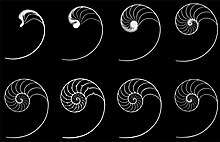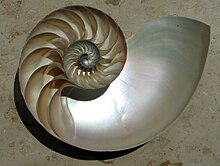Pearl boats
| Pearl boats | ||||||||||||
|---|---|---|---|---|---|---|---|---|---|---|---|---|

|
||||||||||||
| Systematics | ||||||||||||
|
||||||||||||
| Scientific name | ||||||||||||
| Nautilidae | ||||||||||||
| Blainville , 1825 |
The pearl boats (Nautilidae) are a family of cephalopods (Cephalopoda), which in the genera Nautilus and Allonautilus summarize the last five species of the superordinate order of the nautiloids , a taxon that is fossilized in an enormous variety of species.
The pearl boats differ from the other cephalopods living today, the octopus (Coleoidea), by a number of characteristics, which are, however, largely regarded as original characteristics, i.e. characteristics of the ancestral species of all cephalopods.
construction

One of the most striking features that distinguish the nautilids from the other cephalopods, the octopuses (Coleoidea), is the spirally rolled up, mostly whitish and brownish cross-striped outer shell - also called the housing - the interior of which is chambered. The chambers are separated from one another by dividing walls (chamber partitions , septa) curved like a watch glass . A thin tissue tube ( siphon or siphunculus) with blood vessels runs through the center of the chambered part of the shell, known as the phragmocone , through which liquid is pumped out of the chambers to regulate buoyancy and an air-like gas mixture enriched with nitrogen and carbon dioxide is added the chambers can be delivered into it. The shell is three-layered: under the outer periostracum , the membrane made of the organic material conchin , lies a thin outer prismatic layer ( ostracum ) made of prismatic aragonite . The inner layer, the hypostracum , is relatively thick and, like the septa, consists of mother-of-pearl . With their outer shells, pearl boats are among the so-called ectocochleates , as are the extinct ammonites . Outwardly, the ammonites were relatively similar to the nautilids, as they also had housings that were divided into living chamber and phragmocone and almost always rolled up spirally. After what their fossils tell us about the Ammoniten, but they also differ in relatively many details of nautilids, and it is believed that they with the squid, the displaced due to its inward (or reduced) shell as Endocochleaten be referred , are more closely related than with the nautilids.
The largest part of the soft body of the nautilids, the intestinal sac (visceral mass), is always located in the chamber that is immediately adjacent to the opening of the shell - called the mouth or aperture - and which is also the youngest and by far the largest chamber . It is also referred to as the living chamber and as such is distinguished from the phragmocone. Each chamber of the phragmocone represents the rear section of a former living chamber. If the animal moves in a new chamber partition, this new living chamber is, due to the growth of the soft body, larger by a factor of 1.08 than it was after the second youngest chamber partition was drawn in. This is how, among other things, the spiral shape is created. Here, shell material is added almost continuously to the edge of the mouth (peristome). The intestinal sac is enclosed by the mantle (pallium), which also separates the material of the shell. The mantle forms a cavity in the lower (ventral) part of the living chamber, the so-called mantle cavity, into which the gills (ctenidia) protrude and into which the intestines and the exits of the gonads also open. Another feature that distinguishes the nautilids from the squid is that they have four (two pairs) instead of two gills. Therefore nautilids are also known as tetrabranchates ("four-gill") and squids as dibranchies ("two-gill"). Nautilids also do not have an ink bag - the eponymous feature of the octopus. In the event of danger, the entire soft body can be pulled back into the living chamber, whereby the so-called head cap folds down like a trap door and closes the mouth.
The part of the soft body that is usually outside the shell includes the cephalopodium, the cephalopod funnel complex. About 45 pairs of arms sit at the head of the pearl boats. The high number of arms clearly distinguishes the pearl boats from the squids, which only have 8 to 10 arms. Also, unlike the squid, the arms of the pearl boats are not equipped with suction cups. Instead, they secrete a sticky secretion that helps hold the prey or themselves to smooth surfaces. Because of the clear differences to those of the squid, the arms of the nautilids are also known as cirrus or tentacles. Here, the short labial tentacles, which are arranged directly around the mouth opening, are differentiated from the longer digital tentacles, which are arranged around the outside of the labial tentacles. In the 38 digital tentacles, the cirrus are anchored in fleshy sheaths into which they can be completely withdrawn. The individual sheaths of the cirrus go over at their base into the head sheath. A so-called eyepiece tentacle is located on both sides of the head immediately in front of and immediately behind the eye. These tentacles do not secrete any sticky secretions and probably serve as pure tactile organs.
The large eyes of the pearl boats are on the side of the head. In contrast to the squid, these are not lens eyes , but rather primitive pinhole camera eyes , i.e. , invaginations of the outer skin (epidermis) lined with light-sensitive sensory cells, which are only covered by a perforated diaphragm , without lenses and vitreous bodies. In contrast to that of the squid, the epidermis of the nautilids also has no chromatophores .
As is typical for cephalopods, pearl boats move with the help of the recoil principle. Here, water is expelled from the mantle cavity under pressure through a hose-like extension located under the head - the funnel (hyponome). The pressure in the mantle cavity is created differently than in cuttlefish, namely by alternately, slight advancement and retraction of the cephalopodium in the housing: By advancing the cephalopodium, the volume of the mantle cavity is increased and water is sucked into it; by pulling it back, the volume of the mantle cavity is increased reduced in size and so water squeezed out of it. With this method of generating recoil, however, only a comparatively small volume of water can be ejected, which means that the pressure under which it is ejected is also rather low. Therefore, pearl boats do not reach particularly high speeds, especially since the large, gas-filled shell in the water has a relatively strong braking effect. As a result of the recoil drive, the animal rotates ("rocks") slightly in the plane of symmetry ( rocking ) while moving . In experiments in aquariums, pearl boats in the countercurrent showed brief relative maximum speeds of well over 30 centimeters per second, but in calm water they never swam faster than 12 centimeters per second.
Fully grown pearl boats reach a housing diameter of up to 23 cm and an average weight, including housing, of up to 1675 g ( Nautilus belauensis ). Adult males are always wider and larger than adult females. The maximum age can be up to 20 years.
Spread and behavior
The recent species live in the western Pacific and in some areas of the Indian Ocean , exclusively in the tropical area and especially on the slopes of reefs . They are part of the benthos and can be found at sea depths of 0 to 500 m. A depth between 150 m and 300 m seems to be optimal. The depth is determined by predators and the temperature: a water temperature of over 25 ° C seems to be fatal for them. Theoretically, the lower limit of the spread is around 800 m, where the shell would implode .
As nocturnal predators, pearl boats feed primarily on small crabs , but also on carrion and rarely on small fish. The animals usually hide during the day. The number of males is greater than that of females.
Endangerment and Use
Pearl boats are particularly endangered by collecting the shell, which is a popular souvenir and collector's item . a. represents in Indonesia and Fiji. At least two types of pearl boats serve as food and are caught using traps.
Systematics
As the last representatives of what used to be a very widespread group, pearl boats are often referred to as living fossils , a misleading term since, of course, today's pearl boats have undergone a number of changes in their own evolution . However, finds from the Eocene show that there were very similar animals belonging to the same species group as early as 38 million years ago; others assume that the first Nautilus species were as early as the end of the Cretaceous around 60 million years ago.
In general, pearl boats are divided into one or two genera with a total of three to seven species:
Nautilus scrobiculatus was only raised in 1997 by Ward and Saunders due to striking morphological differences (width of the navel and shape of the housing cross-section) to a type species of its own genus - Allonautilus - whereby the species Nautilus perforatus described by Conrad in 1849 is also in this new genus was introduced. A. perforatus , which is only known from empty shells, differs from A. scrobiculatus only in its clear transverse ribbing, that is, through numerous " grooves " that run from the navel over the entire shell to the navel on the opposite side.
Art, math and symbolism

At the time of the Renaissance , magnificent vessels made of pearl boat shells , set in gold and other precious metals, were popular as nautilus cups. A pearl boat shell is also included in the official emblem of the French overseas territory New Caledonia .
The pearl boats are a well-known example of mathematical forms in nature: the ventral edge of the limestone casing of many nautilids, and in particular of the genus Nautilus, corresponds in longitudinal section to a logarithmic spiral .
Because of their high symbolic power, pearl boats are also widespread in literature . For example, a submarine that appears in several of Jules Verne's novels and is under the command of Captain Nemo is named "Nautilus". Inspired by Jules Verne, several ships of the US Navy also carried the name “Nautilus”, including the USS Nautilus (SSN-571) , the world's first nuclear-powered submarine.
literature
- P. Jereb, CFE Roper (Ed.): Cephalopods of the world. An annotated and illustrated catalog of cephalopod species known to date. Volume 1. Chambered nautiluses and sepioids (Nautilidae, Sepiidae, Sepiolidae, Sepiadariidae, Idiosepiidae and Spirulidae) (= FAO Species Catalog for Fishery Purposes. No. 4, Vol. 1 ). Rome 2005, ISBN 92-5105383-9 , Chapter 2. Chambered Nautiluses, pp. 51 ff . ( PDF, 611 kB ).
Web links
Individual evidence
- ^ Yoshio Fukuda: Histology of the long digital tentacles. Pp. 249-256 in: W. Bruce Saunders, Neil H. Landman (Eds.): Nautilus - The Biology and Paleobiology of a Living Fossil. Reprint with additions. Springer, 2009, ISBN 978-90-481-3298-0 .
- ↑ William M. Kier: The functional morphology of the tentacle musculature of Nautilus pompilius. Pp. 257-269 in: W. Bruce Saunders, Neil H. Landman (Eds.): Nautilus - The Biology and Paleobiology of a Living Fossil. Reprint with additions. Springer, 2009, ISBN 978-90-481-3298-0 .
- ↑ John A. Chamberlain, Jr .: Locomotion of Nautilus. Pp. 489-525 in: W. Bruce Saunders, Neil H. Landman (Eds.): Nautilus - The Biology and Paleobiology of a Living Fossil. Reprint with additions. Springer, 2009, ISBN 978-90-481-3298-0 , p. 501 ff.
- ^ RK O'Dor, J. Wells, MJ Wells: Speed, Jet Pressure and Oxygen Consumption Relationships in Free-Swimming Nautilus. Journal of Experimental Biology. Vol. 154, No. 1, 1990, pp. 383-396 ( online ).




